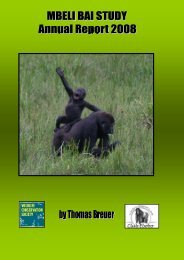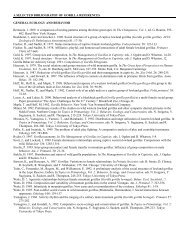First Prosimian Husbandry Workshop 2009 - Cleveland Metroparks ...
First Prosimian Husbandry Workshop 2009 - Cleveland Metroparks ...
First Prosimian Husbandry Workshop 2009 - Cleveland Metroparks ...
You also want an ePaper? Increase the reach of your titles
YUMPU automatically turns print PDFs into web optimized ePapers that Google loves.
Response (Tad Schoffner): We had a low-ranking male and he went crazy scent-marking on the<br />
island until he was exhausted.<br />
Response (Karen Weisenseel): Hediger says don’t clean too much for the loris.<br />
Response (Monica Mogilewsky): Same is true for crowned lemurs.<br />
Question (Monica Mogilewksy.): Does anyone get sores (nest box callus) under tail from scent<br />
marking or sitting on nest box? Is there a material besides wood to be used?<br />
Response (Karen Weisenseel): You need something porous or also you need to be careful with<br />
what you’re cleaning with or treating wood with.<br />
Response (Desiree Haneman): You can use corkwood.<br />
Response (Julie Taylor): We have plastic shelves, but we see the problem.<br />
Response (Monica Mogilewsky): We see this in multiple species.<br />
Response (Laura Suski): It helps to heavily branch on top of the box.<br />
Lorisidae Light Cycle Behavior Study Data Discussion (Grace Fuller, CMZ)<br />
There are currently many different practices employed by different institutions which leads the<br />
stage for more research. I collected 12 hours of data for each animal. The individuals spent the<br />
most time resting, asleep or in their nest boxes. Activity levels are low, regardless of lighting.<br />
Active behaviors did occur throughout the day. 10 AM is the time the animals are fed and the<br />
building is open to the public which may have an influence. My central hypothesis is that high<br />
intensity lighting alters circadian rhythms of activity and hormones in captive lorisines. I am using<br />
three lines of research to address lighting, activity and health. The first part of my research will<br />
include a survey and records review. The second part of this research will involve validating the<br />
use of accelerometers. The third part of this study will look at changing lighting on behavior and<br />
health. We are particularly interested in suppression of melatonin. Blue light knocks out<br />
melatonin more than other wavelengths, which is not a good thing. Zoos can help by filling out in<br />
survey, sending copies of medical and diet records, contribute banked serum, participate in an<br />
actigraph study and participate in lighting study.<br />
25




